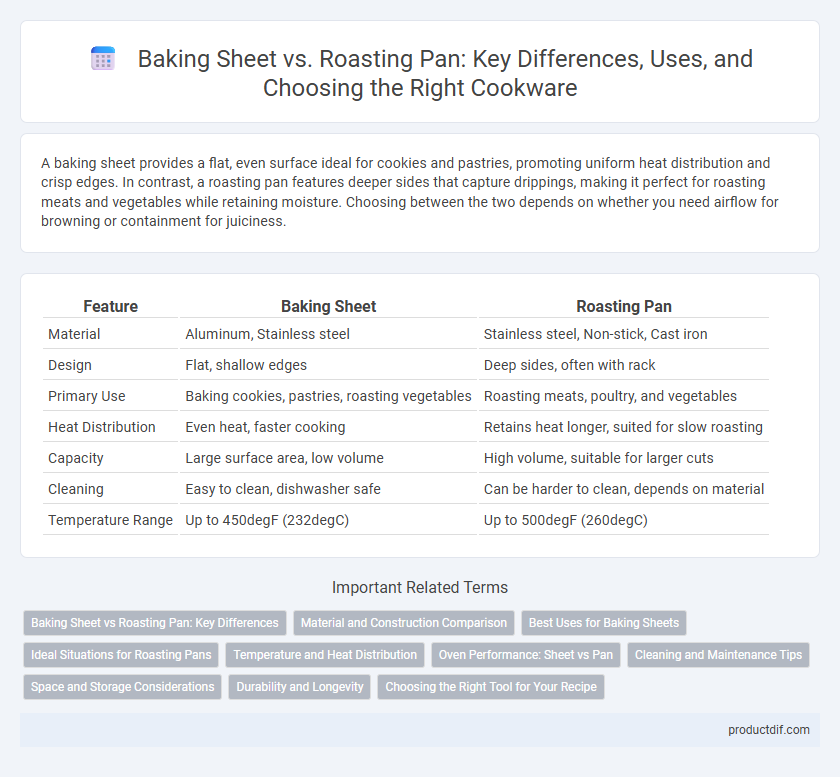A baking sheet provides a flat, even surface ideal for cookies and pastries, promoting uniform heat distribution and crisp edges. In contrast, a roasting pan features deeper sides that capture drippings, making it perfect for roasting meats and vegetables while retaining moisture. Choosing between the two depends on whether you need airflow for browning or containment for juiciness.
Table of Comparison
| Feature | Baking Sheet | Roasting Pan |
|---|---|---|
| Material | Aluminum, Stainless steel | Stainless steel, Non-stick, Cast iron |
| Design | Flat, shallow edges | Deep sides, often with rack |
| Primary Use | Baking cookies, pastries, roasting vegetables | Roasting meats, poultry, and vegetables |
| Heat Distribution | Even heat, faster cooking | Retains heat longer, suited for slow roasting |
| Capacity | Large surface area, low volume | High volume, suitable for larger cuts |
| Cleaning | Easy to clean, dishwasher safe | Can be harder to clean, depends on material |
| Temperature Range | Up to 450degF (232degC) | Up to 500degF (260degC) |
Baking Sheet vs Roasting Pan: Key Differences
Baking sheets feature a flat, rimmed surface ideal for evenly baking cookies, pastries, and vegetables, while roasting pans have higher sides designed to contain juices and accommodate larger cuts of meat or whole poultry. The material composition of baking sheets often includes aluminum for rapid heat conduction, whereas roasting pans commonly use heavier metals like stainless steel or enameled cast iron to withstand intense oven temperatures and prevent warping. Dimensionally, baking sheets prioritize a low profile for maximum air circulation during baking, contrasted by the deep structure of roasting pans essential for collecting drippings and facilitating oven roasting.
Material and Construction Comparison
Baking sheets are typically made from aluminum or stainless steel with a non-stick coating, offering even heat distribution and a flat surface ideal for cookies and pastries. Roasting pans are constructed from heavy-gauge stainless steel, enameled steel, or cast iron, designed to withstand higher temperatures and support large cuts of meat with deeper sides for collecting drippings. The choice of material directly affects heat retention, durability, and the specific cooking techniques suited for each pan.
Best Uses for Baking Sheets
Baking sheets excel in evenly distributing heat, making them ideal for cookies, pastries, and sheet cakes where a flat surface promotes uniform browning. Their low sides and large surface area allow for optimal airflow, which prevents sogginess and ensures crispy edges on baked goods. Lightweight and easy to handle, baking sheets also facilitate quick cooling and efficient storage compared to deeper roasting pans.
Ideal Situations for Roasting Pans
Roasting pans excel in cooking large cuts of meat or poultry, providing ample space for even heat distribution and catching drippings for sauces. Their high sides prevent spills and help contain moisture, making them ideal for slow roasting and braising. Durable materials like stainless steel or heavy-duty aluminum ensure consistent temperature control and easy cleanup after roasting tasks.
Temperature and Heat Distribution
Baking sheets, typically made from aluminum or stainless steel, excel at even heat distribution and withstand temperatures up to 450degF, making them ideal for cookies and pastries. Roasting pans, often constructed from heavier gauge materials like cast iron or enameled steel, tolerate higher oven temperatures around 500degF and retain heat longer, providing consistent cooking for larger cuts of meat. The thicker walls and edges of roasting pans reduce heat loss and promote uniform roasting, while baking sheets offer quicker heat transfer for crispier results.
Oven Performance: Sheet vs Pan
Baking sheets provide even heat distribution and promote crispiness due to their flat surface and low edges, making them ideal for cookies and pastries. Roasting pans, with higher sides and larger volume, retain moisture and facilitate heat circulation for evenly cooked meats and vegetables. Oven performance varies as baking sheets maximize airflow and crispiness while roasting pans enhance moisture retention and deep cooking.
Cleaning and Maintenance Tips
Baking sheets are typically made from non-stick aluminum or stainless steel, making them easy to clean with warm, soapy water and a soft sponge to avoid scratches. Roasting pans, often made from heavy-duty materials like stainless steel or enameled cast iron, may require soaking to loosen baked-on residues and gentle scrubbing to maintain their finish. To extend the lifespan of both, avoid using abrasive cleaners, and ensure they are thoroughly dried after washing to prevent rust or warping.
Space and Storage Considerations
Baking sheets offer a slim, flat design that fits easily in standard kitchen cabinets and can be stacked or slid into tight spaces, ideal for compact storage. Roasting pans are bulkier with higher sides and often include rack accessories, requiring more vertical and horizontal storage space, which can be challenging in small kitchens. Choosing between them depends on available kitchen storage, with baking sheets favoring space-saving and roasting pans demanding larger, dedicated storage areas.
Durability and Longevity
Baking sheets made from heavy-gauge aluminum or stainless steel offer superior resistance to warping and corrosion, ensuring long-term durability in daily kitchen use. Roasting pans typically feature thicker construction and reinforced edges to withstand high temperatures and heavy loads, providing extended longevity under intense cooking conditions. Investing in high-quality materials significantly enhances the lifespan and performance of both baking sheets and roasting pans.
Choosing the Right Tool for Your Recipe
Selecting the right cookware between a baking sheet and a roasting pan depends on the recipe's requirements; baking sheets provide a flat, even surface ideal for cookies and pastries, while roasting pans are deeper, perfect for cooking meats and vegetables with juices. The material also impacts heat conduction, with heavy-gauge aluminum sheets offering quick, even baking and stainless steel roasting pans ensuring durability and heat retention. Consider size and shape versatility to match cooking tasks, as baking sheets facilitate air circulation for crisping, whereas roasting pans accommodate larger cuts and liquid collection for basting.
Baking Sheet vs Roasting Pan Infographic

 productdif.com
productdif.com